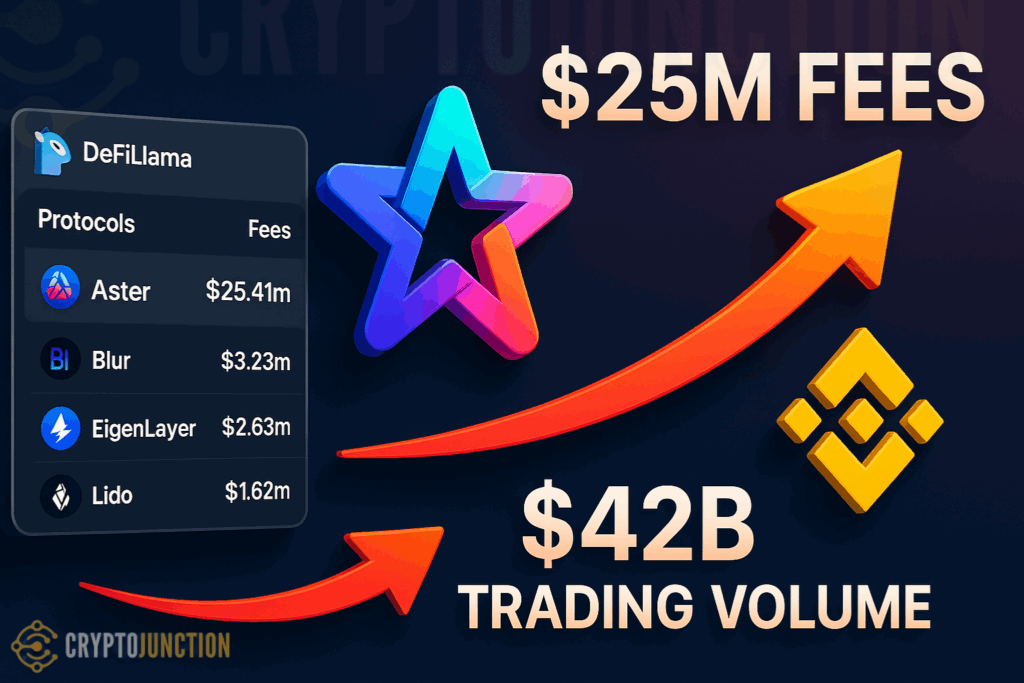Aster, a decentralized perpetual exchange once overlooked by many, has stormed past giants. It claimed the number one spot on DefiLlama’s protocol rankings. With over $25 million in fees earned in just 24 hours and a jaw-dropping $42 billion in trading volume, Aster is rewriting the playbook of DeFi dominance. But the real question is, how did a once-quiet player suddenly outpace its rivals in such spectacular fashion?
Aster’s Record-Breaking Surge Leaves Competitors Behind
The numbers are staggering. According to DefiLlama, Aster raked in $25 million in daily fees. This surpasses established platforms like Hyperliquid, which trailed far behind at $3.17 million. Even more eye-popping, Aster logged $42 billion in 24-hour trading volume. It set a new benchmark that left competitors scrambling for relevance.
This isn’t just about raw numbers, it’s about a carefully orchestrated strategy. Backed by YZi Labs (formerly Binance Labs), Aster has emphasized multi-chain support, with BNB Chain as its launchpad. The platform has evolved rapidly from its earlier identity as APX Finance, later rebranding after merging with Astherus in March. With this rebrand came innovation, positioning Aster as a fresh force in the perpetuals market.
Competitors like Lighter and Hyperliquid still hold respectable positions. Yet, the sheer scale of Aster’s lead suggests a seismic shift in trader preference.
Hidden Orders And Binance’s Backing
Aster’s “hidden orders” feature has traders buzzing. Unlike traditional transparent order books on perpetual DEXs, hidden orders allow users to place invisible limit orders. This masks strategies from competitors. In a market where every move is scrutinized, this innovation gives traders a tactical edge. It fuels curiosity and adoption.
But the real twist came when Binance co-founder Changpeng Zhao publicly endorsed Aster on X. Zhao not only confirmed that YZi Labs holds a minority stake in the project. He also dropped a cryptic line: “Few understand this. Aster competes with Binance, but helps BNB.” The endorsement wasn’t just a nod of approval. It was a signal to the market that Aster is more than a rising star. It’s a rival that commands respect.
The timing couldn’t have been more perfect. Aster launched its token on September 17, sparking a frenzy. Its fully diluted valuation rocketed from $560 million at launch to an eye-catching $15.1 billion today. While the token currently trades at $1.89 -1.76%, the long-term trajectory points to resilience. This is fueled by trader enthusiasm and institutional curiosity.
Aster’s Future: Disruption Or Destiny?
The story of Aster feels like a plot twist straight out of a thriller. Once a lesser-known exchange, it has surged past household names in record time. But can it sustain this momentum? With its bold innovations, Binance ties, and multi-chain roadmap, Aster is positioning itself as not just another player. It is the perpetual DEX to watch in 2025 and beyond.
For traders, this is more than hype. The platform’s deep liquidity, cutting-edge features, and staggering fee generation signal real staying power. Competitors may regroup and innovate, but for now, Aster’s rise represents a defining moment in decentralized finance, a reminder that in crypto, underdogs can transform into titans overnight.

